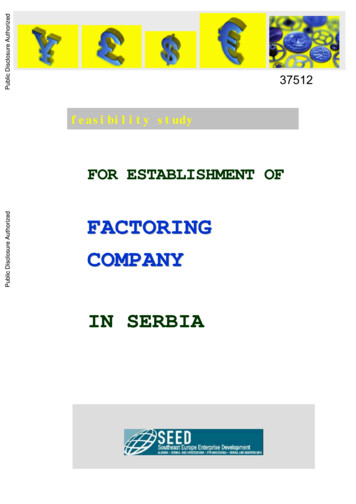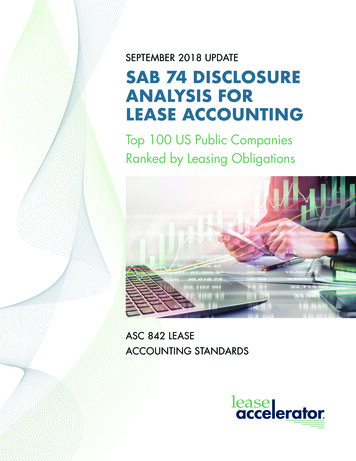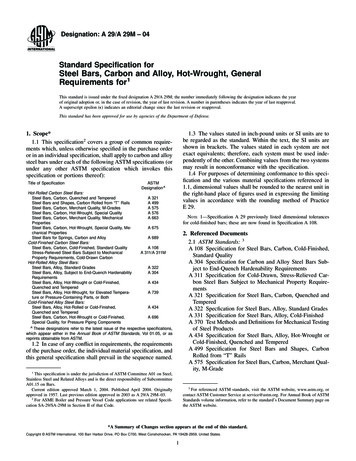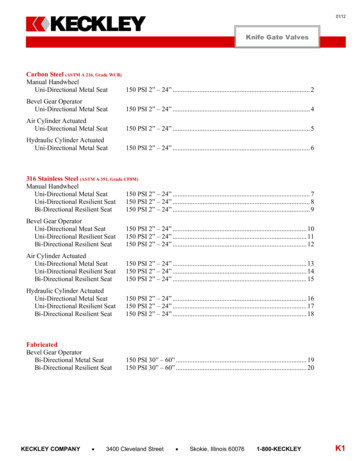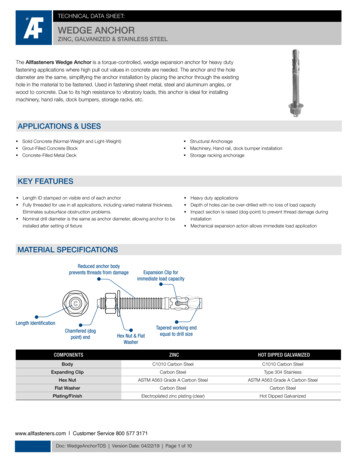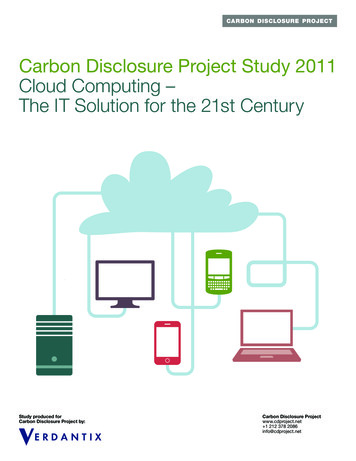
Transcription
Carbon Disclosure Project Study 2011Cloud Computing –The IT Solution for the 21st CenturyStudy produced forCarbon Disclosure Project by:Carbon Disclosure Projectwww.cdproject.net 1 212 378 2086info@cdproject.net
Cloud Computing – The IT Solution for the 21st CenturyForewordCloud Computing – The IT Solution for the 21st CenturyIt is with great pleasure that I introduce this significant and timely study on the nascent technologyof cloud computing and the important role it can play in both increasing business efficiency andreducing greenhouse gas emissions.If the 19th century was the agricultural century, and the 20th century was the century ofmanufacturing, then the 21st century is surely the communications century.Hundreds of millions of people are being pulled from poverty around the world – in particular inChina and India. As we pass this milestone of fundamental human development we can turn tohigher aspirations and goals beyond basic human needs and enrich our society throughdevelopment of Information Technology. This will deliver increasing luxury in entertainment, education,information and communications. The physical goods industries lay the foundations of our moderneconomy; now Information and Communications Technology (ICT) and cloud computing can help enable the full flowering ofhuman potential.A large percentage of global GDP is reliant on ICT – this is a critical issue as we strive to decouple economic growth fromemissions growth. The carbon emissions reducing potential of cloud computing is a thrilling breakthrough, allowing companies tomaximize performance, drive down costs, reduce inefficiency and minimize energy use – and therefore carbon emissions – all atthe same time.The early days of the computer revolution saw a great deal of money invested into ICT – one of the most important economicsectors in the world. There was enormous growth without sufficient thought regarding energy consumption. Now, we at CDPare delighted to be associated with new leadership in the ICT sector in recognizing and responding to the genius of science anddesign through energy efficiency.We can experience a great move forward in this exciting time of technological development with ICT making a decisivecontribution in reducing greenhouse gases and driving down emissions from business, increasing efficiency in operationsand providing the network intelligence vital to reducing energy use and thereby combating climate change.We are seeing an exciting proliferation of digital products including newspapers, music and movies and a growing range ofproducts and services.As we learn to live within the finite physical resources of this world, the future of our expenditure will naturally migrate towards theluxuries of the mind because these sectors of the economy have few limits. Business use of cloud services can play a vital part inmaking this dream a reality.Paul DickinsonExecutive ChairmanCarbon Disclosure Project2
Executive summaryIntroductionThe sustainability agenda of many firmsis increasingly seen as a core strategicpriority. Executives are looking acrossthe entire business to understandways in which they can operate moresustainably and thereby increase theircompetitive edge.ICT is seen as a key area of focus forachieving sustainability goals. Computingrequirements have accelerated rapidlyover the last ten years. Back in 2006,the Environmental Protection Agency(EPA) estimated data centers consumed1.5% of total US electricity1 andthey suggested this was double theconsumption in 2000. With data centergrowth continuing, the Departmentof Energy believes data centers maybe consuming up to 3% of total USelectricity today.Businesses are aware this level ofelectricity usage comes at a cost in bothfinancial and carbon terms. The adoptionof cloud computing allows firms todeliver on sustainability while reducingcosts. Executives are coming to viewcloud computing as a way to transitionto a lower carbon business model whileincreasing the efficiency andeffectiveness of business operations.) “Cloud computing is a modelfor enabling ubiquitous,convenient, on-demandnetwork access to a sharedpool of configurable computingresources (e.g. networks,servers, storage, applications,and services) that can be rapidlyprovisioned and released withminimal management effort orservice provider interaction.”21. http://www.energystar.gov/ia/partners/prod development/downloads/EPA Datacenter Report Congress Final1.pdf2. raftSP-800-145 cloud-definition.pdf3. See appendixKey findingsThis study, produced by independentanalyst firm Verdantix, used detailedcase study evidence from 11 global firmsthat have been using cloud computingfor at least two years. The informationwas used to build a forecast model 3which assesses the financial benefitsand carbon reductions for a firm optingfor a particular cloud computing service 4.The analysis also demonstrates howprojected cloud computing adoptionwould drive economy-wide businessbenefits from a financial and carbonreduction perspective in the US 5.Cloud computing can avoid millionsof metric tons of CO2 A typical food & beverage firmtransitioning its human resources(HR) application from dedicated ITto a public cloud can reduce CO2emissions by 30,000 metric tonsover five years. These reductions areequivalent to the annual emissionsfrom 5,900 passenger vehicles 6. The same food & beverage firmtransitioning its HR application fromdedicated IT to a private internalcloud can reduce CO2 emissions by25,000 metric tons over five years.These reductions are equivalent tothe annual emissions from 4,900passenger vehicles. From an economy-wide standpoint,US businesses with annual revenuesof more than 1 billion can cut CO2emissions by 85.7 million metrictons annually by 2020 as a resultof spending 69% of infrastructure,platform and software budgets oncloud services.4. Forecast was limited to an individual firm due to the significantvariations which exist in the IT estates of different firms5. For firms generating 1 billion plus revenues in the US6. Environmental Protection Agency – Green Power EquivalencyCalculator ential financial benefits fromcloud computing run into billions Through the forecast uptake of cloudcomputing, US businesses withannual revenues of more than 1billion can achieve economy-widesavings in energy alone of 12.3billion a year by 2020.Cloud computing delivers a positivenet present value (NPV) A typical food & beverage firmtransitioning its HR application fromdedicated IT to a public cloud canachieve a NPV of 10.1 million overfive years with a payback period ofunder a year. A typical food & beverage firmtransitioning its HR application fromdedicated IT to a private internal cloudcan achieve a NPV of 4.4 million overfive years with the payback comingduring year two.Cloud computing brings businessefficiency savings Significant non-monetary benefits arealso achieved with cloud computingincluding business process efficiencyand increased organizational flexibility.3
Cloud Computing – The IT Solution for the 21st CenturyContentsIntroduction5Cloud computing explained6Research methodology8Why firms invest incloud computing10Sustainability perspective13How cloud computing deliverseconomy-wide financial benefitsand carbon reductions144Recommendations tomaximize environmentalcloud computing benefits18Glossary19Appendix20
IntroductionThis study, commissioned by the CarbonDisclosure Project and conducted bythe independent analyst firm Verdantix,provides detailed analysis of the financialand carbon benefits of cloud computing.With the aid of a detailed model andlooking specifically at firms generatingat least 1 billion of annual revenues inthe US, we demonstrate how projectedcloud computing adoption will driveeconomy wide benefits from both afinancial and carbon perspective.So what is cloud computing? It is a termwhich has been used in many differentcontexts but the definition we are usingcomes from The National Institute ofStandards and Technology (NIST) 7:“Cloud computing is a modelfor enabling ubiquitous, convenient,on-demand network access to ashared pool of configurable computingresources (e.g. networks, servers,storage, applications, and services thatcan be rapidly provisioned and releasedwith minimal management effort orservice provider interaction).”Cloud computing is a multifaceted concept and needs tobe understood across threedimensions:1. Characteristics. Server virtualization(where multiple server instancesare created on one physical servermachine) is a key element ofthe cloud, allowing for the rapidprovisioning or de-provisioningof services (often referred to aselasticity). Self service is also akey component, allowing users toprovision new or additional servercapacity without requiring interactionfrom the service provider. Thecapabilities are available over anetwork and the services used canbe measured accurately and chargedfor on a usage basis.7. raftSP-800-145 cloud-definition.pdf2. Service delivery. Three main typesof cloud service have emerged.Infrastructure as a service (IaaS)provides the processing, storageand network capability to a user.Platform as a service (PaaS) providesusers with a development platformfor the design and test of customapplications. Software as a service(SaaS) provides applications tousers through a centralized networkallowing access over the internetor intranet.3. Deployment models. Threemain deployment models of cloudcomputing have developed. Publiccloud describes when a third partyis providing the cloud service anddoes so on a multi-tenant basis suchthat different firms share the sameinfrastructure, platform or instanceof the software application. Privatecloud describes a situation where theservice is operated exclusively for oneparticular firm. This service can beprovided either internally or externally,by a third party provider. Finally,hybrid clouds describe a situationwhere the service is delivered througha combination of both the public andprivate cloud models.“ First we saw the need toget infrastructure whichallows us to create avirtualized environment.Following that, we feltwe should partner withan IaaS provider toallow us to scale withouthaving to build our owninfrastructure.”Applied Materials,Jay KerleyVirtual private cloudInternal and external private clouds have been discussed but it is alsovaluable to reference a subset of the external private cloud. Virtual privatecloud (VPC) describes a situation whereby a cloud provider virtuallypartitions (rather than physically partitions which would be a standardexternal private cloud) a portion of a public cloud environment into anisolated environment for exclusive use by a single customer. The service isonly accessible via a private network connection and not through the publicinternet. While our interviewees had not implemented any VPC services, thisis an area which could grow alongside the wider growth in cloud computing.5
Cloud computing explained“ The cloud has enabledus to become a trulyglobal firm.”Aviva,Matthew Dines“ With the cloud, firms geta variable pay-per-usemodel. This is metereddown at the hourly level,rather than a fixedmonthly rate.”AT&T,Jeff Shafer“ We see the cloud asreducing the administrationand headache side of IT,allowing our leadership tofocus on things that arecritical to the business”Aviva,Matthew Dines6Cloud computing is a term with whichmost people will be familiar. It continuesto receive a growing amount of mediaattention. Most people are alreadyinteracting with various types of cloudcomputing services but despite this,cloud computing continues to provean impenetrable concept to manypeople. In essence it is all about whereyour computing resources reside, whomanages them and how you accessand pay for them.Traditionally, each office would have itsown dedicated IT systems with theirown servers, software applications(e.g. email system) and developmentplatforms (e.g. website developmentplatform). These have to be paid for,managed and maintained internally.There are high capital expendituresassociated with purchasing the hardwareand it can be time intensive updating andmaintaining these systems. Also thesesystems are often underutilized as theymust have the capacity to cope with thehighest levels of traffic – this may onlyhappen once a month or once a year.Some large businesses have adopted aprivate cloud approach which meansthat they have consolidated all theirdisparate servers and applications intoone company wide system which ismaintained behind their firewall and canbe accessed across their intranet i.e.they are sharing their resources betweenthe different offices and business units.This means that they can make better,more efficient use of their resourcesbecause they are being shared by morepeople. It also means that their systemsare uniform across the company.Then there are public clouds. Insteadof owning and managing your own ITsystems and hardware you buy theservice from specialist cloud providersand you access them from anywhere viathe internet. Your customer relationshipmanagement systems may be run byone company and the information storedin the provider’s data centers and youremail by another company. There arehuge economies of scale associatedwith this model and therefore theseproviders can make more efficient useof their resources. These services canbe provisioned remotely, quickly and inan on-demand, self provisioned mannerand you pay only for what you need. Thismeans that less time is spent managingsystems and the IT team can focuson innovation to meet their businessobjectives.The diagram on the next page visualizesthese approaches, using an isolatedbusiness, an office block and a businesspark as analogies.
Cloud computing explainedMoving from a traditional architecture can increase the efficiencyof IT operations and decrease emissionsDedicated ITCorporations ownand manage theirown IT resources,each having theirown servers,software andhardware.Private CloudThe CloudWith a private cloud,IT resources are pooledand shared betweendifferent business unitsin the same organisation.The Public CloudVirtualdesktopThe CloudCRMA public cloud deliversIT resources throughspecialist providers todifferent corporations.You only pay for theservices that you use.7
Cloud Computing - The IT Solution for the 21st CenturyResearch methodology“ Once public cloudproviders are moreconfident with the securityof their offering, theywill take on more liabilityand allow firms to movemore of their IT to thepublic cloud.”Boeing,Jim Rubert“ Government legislationon sustainability and dataprotection means cloudcomputing, especiallyoffshore, has to bemonitored closely andmanaged proactively.”CloudApps,Peter Grant8The purpose of this study is to getfirst hand accounts of companies’ useof cloud computing and to quantify thepotential financial and environmentalbenefits that can be attained from thistechnology. For energy and climatechange policy-makers, the analysisexplains how cloud computingcan assist countries to reduceCO2 emissions.This research is based on:1. In-depth case studies with 11multi-national corporations, acrossa broad spectrum of industries, whohave invested in cloud computing.2. In-depth interviews with expertsfrom three global cloud computingservice providers.3. A financial model built to calculate theNPV of cloud computing based on aset of specified assumptions.4. A carbon reduction model builtto calculate carbon reductionsfrom cloud computing based on aseries of parameters including thesize of the firm, the number ofservers, server utilization rates, datacenter power usage effectiveness(PUE), data transmission andembedded energy.5. An economic model, based onfinancial data for over 1,800 globalfirms operating in the US thatforecasts economy-wide financialand environmental benefits fromcloud computing up until 2020.6. The methodology used in thisreport aligns with the assessmentmethodology established by theGlobal e-Sustainability Initiative8(GeSI), a global not for profitassociation which brings togetherleading ICT companies andnon-governmental organizationscommitted to achievingsustainability objectivesthrough innovative technology.We have shown that differentdeployment models exist for cloudcomputing (public, private and hybrid).For the purposes of this study, weanalyzed cloud computing in terms ofpublic and private cloud since that ishow firms allocate spending (hybridcloud merely describes a combinationof these two approaches). We alsoincluded a ‘dedicated IT’ deploymentmodel which can be defined as thetraditional IT deployment approach. Itis a non-cloud based model withoutvirtualized servers and without any ofthe key characteristics associated withcloud computing.Deployment modelsThis report analyzes threeIT deployment models whichare defined as follows:Public cloud – A third partyprovides the cloud serviceon a multi-tenant basis suchthat different firms share thesame infrastructure, platformor instance of the softwareapplication.Private cloud – The firm builds itsown cloud and makes the serviceavailable exclusively within thebusiness (often referred to as aprivate internal cloud).Dedicated IT – A non-cloudservice without virtualized serversand without any of the keycharacteristics associated withcloud computing.8. Methodology.aspx
Research methodologyTable 1 – Industry interviewsFirmNameRoleApplied MaterialsJay KerleyCorporate Vice President and Deputy Chief Innovation OfficerAvivaMatthew DinesHead Of Group IT Strategy & ArchitectureBarclays CapitalDave KingDirector, IT Production EngineeringBoeingJim RubertEnterprise Technical ArchitectBouygues TelecomAlain MoustardChief Innovation OfficerCitigroupPaul StemmlerManaging Director, Engineering and Integration, Citi Global Operations& TechnologyMichelle EricksonInitiative Director, Sustainability & Research, Citi Global Operations& TechnologyDellJohn PfluegerPrincipal Environmental StrategistDeutsche BankMarc BanksLead Domain Architect Eco-Efficient ITJuniper NetworksDhritiman DasguptaDirector, Product MarketingMasum MirSenior Product Line ManagerNovartisJuergen Basse-WelkeLead Architect InfrastructureState StreetMadge MeyerExecutive Vice President, Chief Innovation Officer and TechnologyFellow, State Street CorporationTable 2 – Expert interviews*FirmNameRoleAT&TJeff EspositoAssociate Vice President, AT&T Managed Hosting & Cloud ServicesJeffrey ShaferDirector, AT&T Cloud ServicesCloudAppsPeter GrantChief Executive OfficerIBMRich LechnerVice President, IT Optimization and System Software*Written input was also provided by Hewlett Packard9
Why firms invest in cloud computing“ The challenge for anyinstitution is the time tomarket challenge. Threeyears ago, it would takesix months to approvethe installation of a newserver. Today, a virtualizedserver can be created intwo hours with a click ofa button without the needfor any further manualintervention”Barclays Capital,David KingWe conducted in-depth interviewswith multi-national firms in a diversegroup of sectors: financial services,insurance, pharmaceuticals,technology and telecommunications.The firms interviewed had adoptedcloud services to varying extents for atleast two years.Advantages of adopting acloud modelWhy do firms choose to adopt cloudcomputing and what benefits havethey seen? Our detailed case studiesrevealed a range of factorsencouraging adoption of thecloud. Among the findings: Time to market. Firms looking todevelop and provide new services totheir customers can do this far moreeffectively though a cloud computingmodel. Prior to adopting a cloudbased model, firms indicated it couldtake two to three months to get newserver capacity installed, but a cloudbased model enables the creation ofa new server instance in minutes. Cost savings. Many of theinterviewed firms reported costsavings as a primary motivator.Anticipated cost reductions were ashigh as 40%-50% when implementingan internal private cloud (as opposedto dedicated IT). These savings wouldcome from better use of hardware aswell as a reduced support team. Capex to opex. Firms ordepartments can avoid costly up-frontcapital investments in infrastructureand can fund the purchased servicethrough operational expenditure. Flexibility. Many firms run with alarge amount of excess computingcapacity for much of the time toenable them to handle the spikes inactivity which can occur. Firms foundCase study: Boeing Information Technology“Boeing sees cloud computingas an opportunity to transformits business and processes whileimproving customer and supply chainsatisfaction. Boeing is implementinga hybrid deployment model of bothprivate and secure public cloudservices in an enterprise wide strategywhich optimizes the business growthfrom these investments.Boeing started out on its cloudtransition in 2008 and saw immediatebenefits from server virtualizationin helping to drive energy efficiencyand today, Boeing has over 8,000virtualized servers. However, themost significant impact of the movetowards a cloud based model hasbeen the improvement in processefficiency. Previously, it could takeup to three months to provision andinstall a new server in the data10center. With the developmentof a private cloud for the firm’sinfrastructure, servers will beprovisioned within minutes.Boeing sees opportunities to movesome of its IT estate to the publiccloud but the majority of the cloudservices are private internal clouds.Boeing classifies all of its data andfor the lower sensitivity data, a publiccloud service may be applicable.However, a significant portion ofthe data which Boeing deals withis classified as highly sensitive andpublic cloud providers today aregenerally not willing to take on thelevels of liability necessary to promptBoeing to utilize their services.”Jim Rubert,Enterprise Technical Architect,Boeing Information Technology
Why firms invest in cloud computingthat using a cloud model allowsthem to pay for that excess capacityonly when it is required, resulting inreduced overall costs. Automation. The self-service andincreased automation associatedwith the cloud is found to driveprocess efficiencies with many ofthe firms we spoke with since iteliminates the need to go througha server provisioning team.Barriers to adopting acloud modelWhile a series of cloud computingbenefits were outlined through thecourse of the interviews, firms alsorevealed reasons why they are hesitantto adopt a cloud model. Amongthe findings: P erceived security concerns.This was the area most frequentlyreferenced with respect to restrictingcloud computing investment. Manyfirms remain reluctant to move anyof their services to a public cloude nvironment since they prefer tokeep their data behind their ownfirewalls. This situation is only likelyto change if cloud service providersaccept liability for the data, removingthe litigation risk which currently sitswith the customer regarding dataloss or leakage. S ervice reliability. This has beenbrought into sharp focus withthe April 2011 multi-day outageof Amazon Web Services. Thisoutage resulted in the slow-downand in some cases, shut-down,of prominent internet sites suchas Quora and Reddit. Many firmscannot countenance a similar outageacross their IT estate. V endor lock-in. Firms areconcerned about moving to apublic cloud deployment model sincethey fear becoming dependent onthe provider’s service and exposedto any future price increases inthe subscription. Lack of clarity in the businesscase. While firms can understandthe subscription-based costsassociated with a public cloudservice, understanding how thiscompares to the costs of the existingoperations proves challengingsince it is necessary to identify andcalculate the costs of the hardwareand people that support theexisting operations.“ If clients have workloadsthat only need to runonce a week or month,they can leverage a cloudservice and the costsavings can be immense.”AT&T,Jeff ShaferIndustry variations incloud adoptionThe interviews also revealed variationsby industry in terms of cloud computingadoption. The principle trends were:Financial services firms feelrestricted by data securitylegislation. All the financial servicesfirms interviewed were unwilling to usea public cloud provider to support anyoperations which involved client data.These firms in particular are governedby extremely strict legislation (e.g.Gramm-Leach-Bliley Act) concerning thesecurity of the data and they considereda public cloud provider unable to providethe necessary guarantees.“ Cloud computingoffers faster time tovalue and the ability toquickly scale,”IBM,Rich LechnerTechnology and pharmaceuticalfirms prefer direct control oftheir intellectual property (IP).In these sectors in particular, competitiveadvantage is established mainly throughthe development of IP through theirresearch and development operations.Firms in these industry areas remainhesitant to allow this data to sit outsidetheir firewalls in a public cloud.Telecommunication firmsdemonstrate support for their owncloud solutions. Cloud computingservices have emerged as a fundamentaloffering for telecoms providers. As aresult, telecommunication firms are early11
Cloud Computing – The IT Solution for the 21st Century“ With an internal privatecloud, we expect toreduce costs in termsof total cost of ownership(TCO) by 40-50%. 1015% of that saving willcome from better usageof hardware and the restfrom improved operationsbasically introducing aself-provisioning portalthat requires minimalhuman intervention.”Novartis,Juergen Basse-Welke“ We are experiencingsignificant reuse, andhence carbon reduction,in our internal private cloudenvironment. Fully 1/3of all of the virtual serversrequested in the internalprivate cloud are recycledeach month.”Citigroup,Paul Stemmler12large-scale adopters of private cloudsolutions since they wish to demonstrateconfidence in their own cloud services totheir customers.The financial and business casefor cloud computingThe complexity of the term ‘cloudcomputing’ was outlined in the initialsection with its variations in deliverymethods and deployment models.Added to this, each organization hasa unique IT estate (the entire suite ofinformation technology which supportsthe business) and will seek to leveragecloud services in different ways. Theamount paid for a particular softwarelicense or cloud service subscriptionwill also vary by firm. As a result, thebusiness case for cloud computing istypically a company specific exercise,and in this report a business case hasbeen generated for a hypothetical food& beverage firm.The environmental case forcloud computingCloud computing has the potential toreduce firms’ carbon emissions. Throughvirtualization and running servers athigher utilization rates, the total energyrequired to support a given service isreduced, which results in lower carbonemissions. Added to this is the fact thatfor public clouds in particular, providersfocus on the efficiency of the data centeras a whole (data center PUE) andgenerally run data centers at lower PUEs.Data center PUEPower usage effectiveness(PUE) is a data center efficiencymeasure and calculates theratio of total power consumedby a data center against thetotal power consumed by theIT equipment. This measurehas attracted a certain level ofcriticism due to variations ininterpretation over what shouldbe included in the total datacenter power consumptioncalculation as well as questionsaround temporal variations in themeasure. Attempts to providegreater standardization aroundthis measure have been madeby the Green Grid in a May 2011publication10. For the purposes ofthis report, average PUE valueswere applied to public cloud,private cloud and dedicated ITdeployment environments andwere based on data obtainedthrough the study interviews andextensive additional research.The critical inputs into our analysis tocalculate carbon reductions from cloudcomputing are 9: Number of servers Server utilization rate Maximum and idle serverpower ratings Network and storage utilization rate Data center PUEs Embedded server energy Energy for data transmission Size of firm (by revenue)9. The model schematic and key assumptions used in themodel can be found in the appendix10. http://www.thegreengrid.org/ ng en
Sustainability perspectiveAndrew Winston –A leading expert onsustainable businessand author of ‘Greento Gold’ and ‘GreenRecovery’ gives hisview on the role cloudcomputing can playin sustainabilitybusiness strategy.http://www.andrewwinston.com/as one of five operational areas wheregreen initiatives help companies savemoney quickly (the others were facilities,distribution, telework, and waste).Cloud computing is all the rage. In itssimplest terms, it means centralizingyour company’s information technology(IT), from data and storage to software.All the servers and applications sitelsewhere in the Internet “cloud”, butmore literally in a data center or centers.You can request these additionalresources when you need them andyou only pay for what you use.Data centers can lose up to 96% of theenergy coming into the building, losingefficiency in three key areas: cooling theroom, cooling the servers, and keepingservers idle (utilization rates as low as10 to 20 percent)11. Using the cloudcan help in all these areas. Modern datacenter design tackles room and servercooling and “virtualization” techniques,used at scale, can address the absurdwaste, in percentage terms, from serverunderutilization.This report shows that US companiesare set to increase their adoption ofcloud computing over the next decadefrom 10% to 70% of their IT spend.The predicted adoption could save 85.7million ton
of cloud computing and the important role it can play in both increasing business efficiency and reducing greenhouse gas emissions. If the 19th century was the agricultural century, and the 20th century was the century of manufacturing, then the 21st century is surely the communications century.


